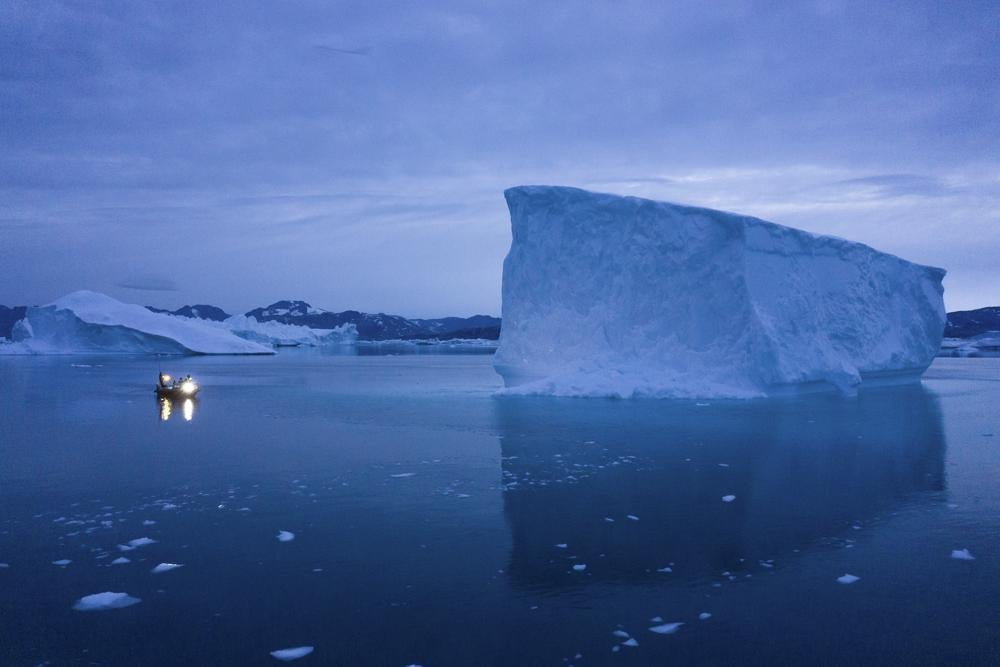Greenland ice sheet ‘could be more vulnerable to climate change than first thought’
Huge body of frozen water is key to global sea levels

One of the world’s largest ice sheets, which is key to global sea levels and the wider climate, is more vulnerable than previously thought, according to new research.
Scientists say rising air temperatures amplify the effects of melting caused by ocean warming, leading to greater ice loss from the Greenland ice sheet.
The Greenland and Antarctic ice sheets are two of the largest bodies of ice in the world and have been shrinking at an increasing rate since the 1990s.
This melting has contributed to about one-third of global sea level rise over the same period, according to the European Environment Agency.
The cumulative ice loss from Greenland from 1992 to 2017 was 3.9bn tonnes, which contributed approximately 11mm of the global sea level rise, the EEA said.
The corresponding figures for Antarctica are 2.6 billion tonnes, equivalent to a 7mm contribution.
Previous studies have shown that rising air and ocean temperatures both cause the Greenland ice sheet to melt.
But the new research, carried out by scientists at the Universities of Edinburgh and California San Diego, US, reveals how one intensifies the effects of the other.
Experts liken the effect to how ice cubes melt more quickly if they are in a drink that is being stirred – the combination of warmer liquid and movement accelerates their demise.
In Greenland, amplification of the ice sheet occurs when warm air temperatures melt its surface, generating meltwater.
Meltwater flowing into the ocean creates turbulence that results in more heat melting the edges of the ice sheet submerged in the ocean – so-called submarine melting.
Researchers evaluated submarine melting of the Greenland ice sheet – which covers more than 650,000 square miles – over a 40-year period from 1979 to 2018.

To determine the impact of both warming air and seas on ice sheet loss they used observational data and computer modelling to analyse the effect each had on submarine melting.
The team found that air temperature has had almost as much impact as ocean temperature on submarine melting, with some regional variations.
For example, ocean temperature is the main factor that controls submarine melting in south and central-west Greenland, while atmospheric warming is equally damaging in the island’s northwest.
The findings suggest that if the atmosphere had not warmed since 1979, the retreat of Greenland’s glaciers, driven by submarine melting, could have been reduced by half in the northwest region, and by a third across Greenland as a whole.
The study, published in the journal Nature GeoScience, was supported by the UK Natural Environment Research Council and the US National Science Foundation.
Dr Donald Slater, of the University of Edinburgh’s School of GeoSciences, who led the study, said: “The effect we investigated is a bit like ice cubes melting in a drink – ice cubes will obviously melt faster in a warm drink than in a cold drink, hence the edges of the Greenland ice sheet melt faster if the ocean is warmer.
“But ice cubes in a drink will also melt faster if you stir the drink, and rising air temperatures in Greenland effectively result in a stirring of the ocean close to the ice sheet, causing faster melting of the ice sheet by the ocean.”
He added: “This, unfortunately, adds to the overwhelming body of evidence showing the sensitivity of the Greenland ice sheet to climate change, hence the need for urgent action to reduce greenhouse gas emissions.”






Join our commenting forum
Join thought-provoking conversations, follow other Independent readers and see their replies
Comments